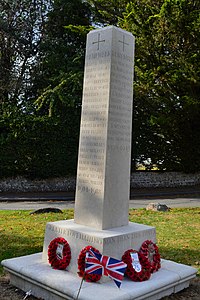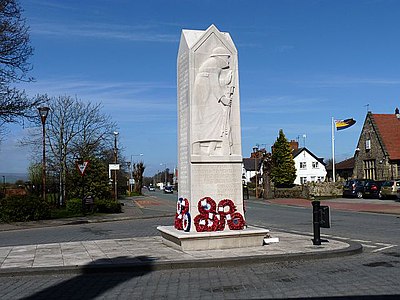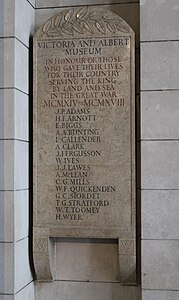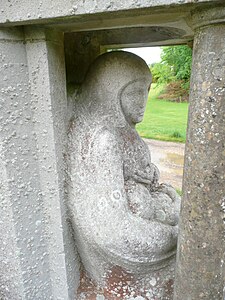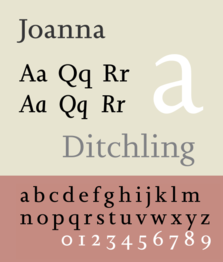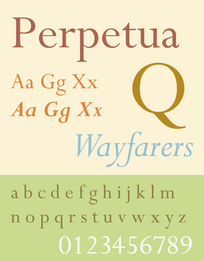Eric Gill
Eric Gill Westminster Technical Institute | |
|---|---|
| Known for | Sculpture, typography |
| Movement | Arts and Crafts movement |
| Spouse |
Ethel Hester Moore (m. 1904) |
| Children | 4 |
Arthur Eric Rowton Gill
Gill was born in Brighton and grew up in Chichester, where he attended the local college before moving to London. There he became an apprentice with a firm of ecclesiastical architects and took evening classes in stone masonry and calligraphy. Gill abandoned his architectural training and set up a business cutting memorial inscriptions for buildings and headstones. He also began designing chapter headings and title pages for books.
As a young man, Gill was a member of the
In 1924, the Gill family left Ditchling and moved to an isolated, disused monastery at Capel-y-ffin in the Black Mountains of Wales. The isolation of Capel-y-ffin suited Gill's wish to distance himself from what he regarded as an increasingly secular and industrialised society, and his time there proved to be among the most productive of his artistic career. At Capel, Gill made the sculptures The Sleeping Christ (1925), Deposition (1925), and Mankind (1927). He created engravings for a series of books published by the Golden Cockerel Press considered among the finest of their kind, and it was at Capel that he designed the typefaces Perpetua, Gill Sans, and Solus. After four years at Capel, Gill and his family moved into a quadrangle of properties at Speen in Buckinghamshire. From there, in the last decade of his life, Gill became an architectural sculptor of some fame, creating large, high profile works for central London buildings, including both the headquarters of the BBC and the forerunner of London Underground. His mammoth frieze The Creation of Man was the British Government's gift to the new League of Nations building in Geneva. Despite failing health Gill was active as a sculptor until the last weeks of his life, leaving several works to be completed by his assistants after his death.
Gill was a prolific writer on religious and social matters, with some 300 printed works including books and pamphlets to his name. He frequently courted controversy with his opposition to industrialisation, modern commerce, and the use of machinery in both the home and the workplace. In the years preceding World War II, he embraced pacifism and left-wing causes.
Biography
Early life
Eric Gill was born in 1882 in Hamilton Road,
In 1897, the family moved to Chichester, when Arthur Tidman Gill left the Countess of Huntingdon's Connexion, became a mature student at Chichester Theological College and joined the Church of England.[1][2]: 19 Eric Gill studied at Chichester Technical and Art School, where he won a Queen's Prize for perspective drawing and developed a passion for lettering.[2]: 26 Later in his life, Gill cited the Norman and medieval carved stone panels in Chichester Cathedral as a major influence on his sculpture.[3][4] In 1900 Gill became disillusioned with Chichester and moved to London to train as an architect with the practice of W. D. Caröe, specialists in ecclesiastical architecture with a large office close to Westminster Abbey.[1]
London 1900–1907
Frustrated with his architectural training, Gill took evening classes in
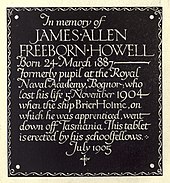
During 1903, Gill gave up training in architecture to become a calligrapher, letter-cutter and monumental mason.
In 1904 Gill married Ethel Hester Moore (1878–1961), a former art student, later known as Mary, the daughter of a businessman who was also the head verger at Chichester Cathedral.[2]: 31 Gill and Moore would eventually have three daughters and foster a son.[1] After a short period in Battersea, the couple moved into 20 Black Lion Lane, Hammersmith in west London, near the, recently married, Johnstons' home on Hammersmith Terrace.[7] A number of artists associated with the Arts and Crafts movement, including Emery Walker, T. J. Cobden-Sanderson and May Morris were already based in the area, as were a number of printing presses, notably the Doves Press.[2]: 64 Gill formed a business partnership with Lawrence Christie and recruited a number of staff, including the 14-year old Joseph Cribb, to work in his studio.[2]: 66 Gill began giving lectures at the Central School and taught courses in monumental masonry and lettering for stonemasons at the Paddington Institute.[2]: 102 In 1905 he was elected to the Arts and Crafts Exhibition Society and joined the Fabian Society the following year.[2]: 101 After a period of intense involvement with the Fabians, Gill became disillusioned with both them and the Arts and Craft movement. By 1907 he was writing and making speeches about the failures, both theoretical and practical, of the craft movement to resist the advance of mass-production.[2]: 93
In his diaries, Gill records two affairs while living at Hammersmith. He had a brief affair with the family maid while his wife was pregnant and then a relationship with Lillian Meacham, who he met through the Fabian Society.[2]: 95 Gill and Meacham visited the Paris Opera and Chartres Cathedral together and when their affair ended, she became an apprentice in Gill's workshop and remained a family friend throughout her life.[2]: 95
Ditchling Village 1907–1913
In 1907, Gill moved with his family to Sopers, a house in the village of Ditchling in Sussex, which would later become the centre of an artists' community inspired by Gill. Although by April 1908 Gill had established a workshop in Ditchling and dissolved his business partnership with Lawrence Christie, he continued to spend considerable amounts of time in London visiting clients and delivering lectures, while his wife Ethel organised their household and smallholding in Sussex.[2]: 120 In London, Gill would stay at his old lodgings in Lincoln's Inn with his brother Max or with his sister Gladys and Ernest Laughton, her future husband.[2]: 122 Gill continued to concentrate on lettering and inscriptions for stonework and employed a pupil for his signwriting business.[2]: 126 He also began to use wood engraving techniques for his book illustration work, notably for a 1907 edition of Homer for Count Kessler.[2]: 126
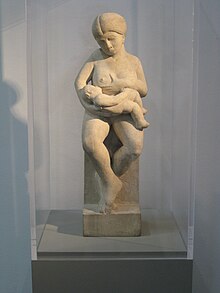
Late in 1909 Gill decided to become a sculptor.[2]: 126 Gill had always considered himself an artisan craftsman rather than an artist. He rejected the usual sculpture technique of first making a model and then scaling up using a pointing machine, in favour of directly carving the final figure.[4][8] His first sculptures included Madonna and Child (1910), which the art critic Roger Fry described as a depiction of "pathetic animalism",[9] and the almost life-size work now known as Ecstasy (1911).[4] The models for Ecstasy were his sister Gladys Gill and her husband Ernest Laughton.[2]: 104 [10] The incestuous relationships between Gill and Gladys that continued during their lives had already begun at this point.[2]: 104 [4] There is also some evidence, from Gill's own writings, of an incestuous relationship with Angela, another of his sisters.[2]: 105 [10]
An early admirer of Gill's sculptures was
Gill had his first sculpture exhibition in 1911 at the Chenil Gallery in London.[9] Eight works by Gill were included in the Second Post-Impressionism Exhibition organised by Roger Fry at the Grafton Galleries in London during 1912 and 1913.[13]
By 1912, while Gill's main source of income was from gravestone inscriptions, he had also carved a number of
Westminster Cathedral 1914–1918

In 1913, after Gill and his wife became Roman Catholics they moved to Hopkin's Crank at
Gill had been granted exemption from military service while working on the Stations of the Cross and when they were finished spent three months, from September 1918, as a driver at an RAF camp in Dorset, before returning to Ditchling.[2]: 138
Ditchling Common 1918–1924
After World War I, together with
Alongside the Guild, Pepler set up the St Dominic's Press with a 100-year old
Along with his Guild work and illustrations, Gill designed several war memorials in this period. These included the Trumpington War Memorial in Cambridgeshire, the Chirk War Memorial in north Wales, the memorial at Ditchling, and the wall panel recording 228 names of the fallen in the ante-chapel at New College, Oxford.[1][18][19][20] Gill also created the memorial at Briantspuddle in Dorset and, with Chute and Hilary Stratton, the monument at South Harting.[21][22] Beside the main entrance to the British Museum, Gill designed and carved, with Joseph Cribb, the memorial inscription to the museum staff killed in the conflict and for the Victoria and Albert Museum, again with Cribb, he created the war memorial in that museum's entrance hall.[23][24] Previously, in 1911, Gill had cut the inscription for the foundation stone of the British Museum's new King Edward VII building.[5] Gill's other significant work from this period was the Stations of the Cross that he carved, with Chute, for the Church of St Cuthbert in the Manningham area of Bradford.[25]
-
St George, detail of South Harting war memorial, West Sussex
-
Ditchling war memorial, Sussex
-
Chirk War Memorial, Wrexham
-
Victoria & Albert Museum staff war memorial
-
Detail of Briantspuddle war memorial, Dorset
Commissioned to produce a war memorial for the University of Leeds, Gill produced a frieze depicting the Cleansing of the Temple but showing contemporary merchants as the money-changers Jesus was driving from the Temple.[26][27] While fully aware that this was an inappropriate subject for a war memorial and one likely to cause great offence in a commercial centre such as Leeds, Gill persisted with the design regardless. The cartoon-like nature of the finished frieze, which included the Hound of St Dominic knocking over a cash till, only added to the ferocity of the resulting uproar.[2]: 166 [28]
Even before the Leeds memorial controversy, Gill's series of illustrations that included the Nuptials of God, The Convert and Divine Lovers and his views on the sexual nature of Christianity were causing alarm within the Roman Catholic hierarchy and distancing Gill from other members of the Ditchling community.[2]: 164 The series of life-drawings and prints of his daughters, including Girl in Bath and Hair Combing done at Ditchling, were considered among Gill's finest works. The sexual abuse Gill was perpetrating on his two eldest daughters during the same period only became known after his death.[4]
A number of professional craft workers joined the community, such that by the early 1920s the community had grown to 41 people, occupying several houses in the 20 acres surrounding the Guild's chapel and workshops.
However, Gill became disillusioned with the direction of the Guild and fell out badly with his close friend Pepler, partly over the latter's wish to expand the community and form closer ties with Ditchling village and also because Gill's daughter, Betty, wanted to marry Pepler's son, David.
Capel-y-ffin 1924–1928
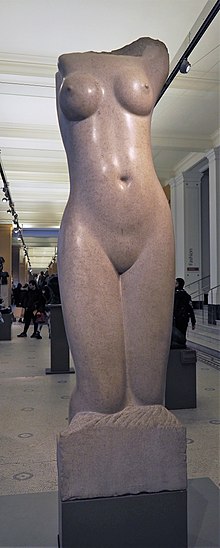
In August 1924, the Gills left Ditchling and, with two other families, moved to a disused Anglican monastery,
Within a few weeks of arriving at Capel-y-ffin, Gill completed Deposition, a black marble torso of Christ, and made The Sleeping Christ, a stone head now in
When approached, in 1924, by Robert Gibbings to produce designs for the Golden Cockerel Press which he and his wife, Moira, had recently acquired, Gill initially refused to work with the couple as they were not Catholics. Gill changed his mind when they sought to publish a volume of poems by his sister Enid. The relationship between Gill and the Gibbingses grew such that throughout the following ten years Gill became the chief engraver and illustrator for the Golden Cockerel Press. Several of the resulting books, including The Song of Songs (1925), Troilus and Criseyde (1927), The Canterbury Tales (1928), and The Four Gospels (1931) are considered classics of specialist book production.[2]: 187 Gill created striking designs that unified and integrated illustrations into the text and also created a new typeface for the Press.[5] The erotic nature of The Song of Songs and of the illustrations for Edward Powys Mathers's Procreant Hymn caused considerable controversy in Roman Catholic circles and led to protracted arguments between Gill and members of the clergy.[2]: 211 [30] The Golden Cockerel printed four of Gill's own books and he illustrated a further thirteen works for the press.[5] In addition, between 1924 and his death, Gill wrote 38 books and illustrated a further 28.[5]
The other key working relationship Gill established while at Capel-y-ffin was with
While living at Capel-y-ffin, Gill spent many weekends at Robert and Moira Gibbings home in
It had been too impractical to transport the stone for Mankind to Capel-y-ffin and it was clear that the site had become too remote and isolated for Gill's increasing commercial workload and by May 1928 he was seeking a new home for his family and workshops.[2]: 221 [30]
-
Gill Sans
-
Joanna Nova
-
Perpetua
-
Golden Cockerel type
-
Three typefaces by Gill
Pigotts, Buckinghamshire 1928–1934
In October 1928, the Gill family moved to Pigotts at Speen, five miles from High Wycombe in Buckinghamshire. Around a quadrangle with a central pigsty were a large farmhouse housing Eric and Mary Gill, a cottage for Petra and her husband Denis Tegetmeier and another for Joanna and René Hague. Stables and barns were converted to studios and workshops and to house printing presses.[2]: 225 A chapel was fitted into one corner and licensed within six months for the saying of Mass.[2]: 226

The success of his 1928 exhibition at the Goupil Gallery had raised Gill's profile considerably and led to Charles Holden commissioning him to lead a team of five sculptors, including Henry Moore, in creating some of the external sculptures for the new headquarters building of the London Electric Railway, the forerunner of London Underground.[2]: 228 Gill started on the project within days of arriving at Pigotts and worked on site in London from November 1928 to carve three of eight relief sculptures on the theme of The Four Winds for the building.[2]: 229
Art-Nonsense And Other Essays by Eric Gill was published in 1929 and marked the first commercial use of the Perpetua typeface. The frontispiece of the book had an engraving of Belle Sauvage, an image of a naked women stepping out of some woods. The various versions of Belle Sauvage became among the most popular of Gill's illustrations and were modelled by Beatrice Warde, a historian of typography, an executive of the Monotype Corporation and sometimes Gill's lover.[2]: 232 By 1930 Gladys Gill had divorced her second husband after her first, Ernest Laughton, had been killed in the Battle of the Somme, and she and Eric appear, from his diary entries, to have resumed their incestuous relationship.[2]: 239 Later that same year the diaries record what Gill called his 'experiments' with a dog.[2]: 239 In September 1930 he was taken seriously ill with a variety of symptoms, including amnesia, and spent several weeks in hospital.[2]: 237

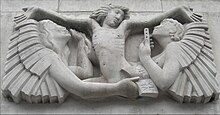
The following two years were among the most creatively accomplished of Gill's career, with several notable achievements. The Hague and Gill press was established at Pigotts in 1931 and eventually printed 16 of Gill's own books and booklets while he also illustrated six other books for the company.[5] For the Hague and Gill press he created the Joanna typeface, which was eventually adapted for commercial use by Monotype. He completed The Four Gospels, widely considered to be the finest of all the books produced by the Golden Cockerel Press, and began working on the sculpture Prospero and Ariel for the BBC's Broadcasting House in London.[2]: 243 Throughout 1931 and into 1932, Gill worked on Prospero and Ariel, and four other works for the BBC, on site in central London.[2]: 245 Carving in the open air up on scaffolding in the middle of London further increased Gill's public profile.[2]: 247 Although Gill had accepted the BBC's choice of subject matter when he took the commission, he did not see its relevance and frequently claimed that the figures he created represented God the Father and God the Son, the latter complete with the marks of the stigmata.[8][32]
The
Jerusalem and Pigotts, 1934–1938

In 1934 Gill, with Lawrence Cribb, visited Jerusalem to work at the
Gill's two visits to Jerusalem had a profound impact on his state of mind. He became increasingly unhappy with the impact of humanity upon the world and also become convinced of his own role as one chosen by God to change society.
Gill's 1935 essay All Art is Propaganda marked a complete reversal of his previous belief that artists should not concern themselves with political activity.
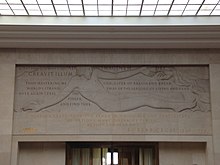
Gill was commissioned to produce a sequence of seven bas-relief panels for the façade of The People's Palace, now the Great Hall of
In 1935, Gill was elected an Honorary Associate of the
Final works, 1939–1940
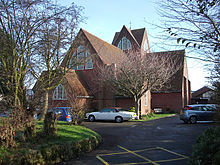

During 1938 and 1939 Gill designed his only complete piece of architecture, the Roman Catholic Church of St Peter the Apostle at Gorleston-on-Sea.[1] He designed the building around a central altar which, at the time, was considered a radical departure from the Catholic practice of the altar being at the east end of a church.[2]: 280
Gill's final publications included Twenty-Five Nudes and Drawings from Life both of which included drawings of Daisy Hawkins, the teenage daughter of the Gills' housekeeper with whom Gill began an affair in 1937.[1] The affair lasted two years during which time Gill drew her on an almost daily basis. When Hawkins was sent away from Pigotts, to the boarding house at Capel-y-ffin run by Betty Gill, Eric Gill followed her there to continue the relationship.[2]: 284
Among Gill's last sculptures were a series of commissions for Guildford Cathedral. He spent time between October and December 1939 working at Guildford, on scaffolding carving the figure of John the Baptist.[1] He also worked on a set of panels depicting the stations of the cross for the Anglican St Alban's Church in Oxford, finishing the drawings three weeks before he died and completing nine of the pieces himself.[42][29] For the Chapel of Saint George and the English Martyrs, in Westminster Cathedral, Gill designed a low relief sculpture to occupy the wall behind the altar.[16] Gill's design showed a life-sized figure of Christ the Priest on the cross attended by Sir Thomas More and John Fisher.[16] Gill died before the work was completed and Lawrence Cribb was tasked with finishing the piece by the Cathedral authorities who insisted he remove an element of Gill's original design, a figure of a pet monkey.[16] When the chapel was eventually opened to the public this censorship of Gills' last work was a matter of some considerable controversy.[16]
From the end of 1939 into the middle of 1940, Gill had a series of illnesses, including rubella, but managed to write his autobiography that summer.[1] Gill died of lung cancer in Harefield Hospital in Middlesex on the morning of Sunday 17 November 1940 and, after a funeral mass at the Pigotts chapel, was buried in Speen's Baptist churchyard.[1]
After Gill died an inventory of over 750 of his carved inscriptions was compiled, in addition to the over 100 stone sculptures and reliefs, 1000 engravings, the several typeface designs he created and his 300 printed works including books, articles and pamphlets.[2]: 294
Sexual abuse
Gill's religious beliefs did not limit his sexual activity, which included several extramarital affairs. His religious views contrast with his
Gill's daughter Petra Tegetmeier, who was alive at the time of the MacCarthy biography, described her father as having "endless curiosity about sex" and that "we just took it for granted", and told her friend Patrick Nuttgens she was unembarrassed. The children were educated at home and, according to Tegetmeier, she was then unaware of how her father's behaviour would seem to others.[17][45] Despite the acclaim the book received, and the widespread revulsion towards aspects of Gill's sexual life that followed publication, MacCarthy received some criticism for revealing Gill's incest in his daughter's lifetime.[46][47] Others, notably Bernard Levin, thought she had been too indulgent towards Gill.[44] MacCarthy commented:
after the initial shock, [...] as Gill's history of adulteries, incest, and experimental connection with his dog became public knowledge in the late 1980s, the consequent reassessment of his life and art left his artistic reputation strengthened. Gill emerged as one of the twentieth century's strangest and most original controversialists, a sometimes infuriating, always arresting spokesman for man's continuing need of God in an increasingly materialistic civilization, and for intellectual vigour in an age of encroaching triviality.[1]
Despite MacCarthy's revelations, for several years Gill's reputation as an artist continued to grow but, following the exposure of other high-profile paedophiles, this changed with groups and individuals calling for the removal of works by Gill.[48]
In 1998, a group, Ministers and Clergy Sexual Abuse Survivors, called for the Gill's Stations of the Cross to be removed from Westminster Cathedral, leading to a debate within the British Catholic press. In January 2022, a man climbed the façade of Broadcasting House and damaged the statue of Prospero and Ariel with a hammer, while another man shouted about Gill's
When, in 2017, the journalist Rachel Cooke contacted museums holding Gill's work to question what, if any, impact the abuse revelations had on their policy towards showing material by him, the majority refused to engage with her.[48] A notable exception was the Ditchling Museum of Art + Craft, which holds many examples of Gill's work and also Gill family objects. Previously, in October 2016, the museum had held a workshop, Not Turning a Blind Eye, with artists, curators and journalists invited to discuss how to address Gill's behaviour in its exhibition programme.[48] This resulted in a 2017 exhibition Eric Gill: The Body and a commitment by the museum to include at least one display highlighting Gill's offending in its permanent exhibitions.[48][56] However in 2022, The Observer reported that it appeared that the museum had decided to reduce the prominence given to Gill's work among its exhibits.[57]
Typefaces and inscriptions
In 1909, Gill carved Alphabets and Numerals for a book, "Manuscript and Inscription Letters for Schools and Classes and for the Use of Craftsmen", compiled by Edward Johnston. He later gave them to the Victoria and Albert Museum so they could be used by students at the Royal College of Art. In 1914, Gill had met the typographer
-
Alphabets and Numerals (1909)
-
Sir Harry Johnston memorial plaque
-
British Railways sign at Lowestoft railway stationin Gill Sans
-
Gill Sans typeface
Gill's other types include:
- Golden Cockerel Press Type (for the Golden Cockerel Press; 1929)[60] Designed bolder than some of Gill's other typefaces to provide a complement to wood engravings.[61][62][63][64][65]
- Solus (1929)[66][60]
- Aries (1932)[60]
- Floriated Capitals (1932)[60]
- Bunyan (1934)
- Pilgrim (recut version of Bunyan; 1953)[60]
- Jubilee (also known as Cunard; 1934)[60]
These dates are not precise, since a lengthy period could pass between Gill creating a design and it being finalised by the Monotype drawing office team (who would work out many details such as spacing) and cut into metal.[67] In addition, some designs such as Joanna were released to fine printing use long before they became widely available from Monotype.
One of the most widely used British typefaces, Gill Sans, was used in the classic design system of
The family Gill Facia was created by Colin Banks as an emulation of Gill's stone carving designs, with separate styles for smaller and larger text.[68]
Gill was commissioned to develop a typeface with the number of allographs limited to what could be used on Monotype systems or Linotype machines. The typeface was loosely based on the Arabic Naskh style but was considered unacceptably far from the norms of Arabic script. It was rejected and never cut into type.[69][70][71]
Published works
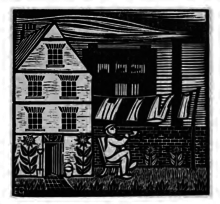
Gill published numerous essays on the relationship between art and religion, and a number of erotic engravings.[72]
Gill's published writings include:

- Christianity and Art, 1927
- Art-nonsense and other essays, Cassell 1929 (pocket edition 1934)
- Clothes: An Essay Upon the Nature and Significance of the Natural and Artificial Integuments Worn by Men and Women, 1931[73]
- An Essay on Typography, 1931[74]
- Beauty Looks After Herself, 1933
- Unemployment, 1933
- Money and Morals, 1934
- Art and a Changing Civilization, 1934
- Work and Leisure, 1935
- The Necessity of Belief, 1935
- Work and Property, 1937[75]
- Work and Culture, Journal of the Royal Society of Arts, 1938
- Twenty-five nudes, 1938[76]
- And Who Wants Peace?, 1938
- Sacred and Secular, 1940
- Autobiography: Quod Ore Sumpsimus[77]
- Notes on Postage Stamps[78]
- Christianity and the Machine Age, 1940.[79]
- On the Birmingham School of Art, 1940
- Last Essays, 1943
- A Holy Tradition of Working: passages from the writings of Eric Gill 1983.[80]
Gill provided woodcuts and illustrations for several books including:
- Gill, Eric (1925). Song of Songs. Waltham St. Lawrence, Berkshire: Golden Cockerel Press.
- The Four Gospels. Golden Cockerel Press. 1931. Facsimile edition published by Christopher Skelton at the September Press, Wellingborough, 1987.
- Chaucer, Geoffrey (1932). Troilus and Criseyde. Translated by Krapp, George Philip. New York: Literary Guild.
- Shakespeare, William (1939). Henry the Eighth. New York: Limited Editions Club.
- The Passion of Our Lord Jesus Christ, according to the four evangelists. Hague & Gill Printers. 1934 Faber & Faber
-
Eve, 1926
-
Christ on the Cross
-
Angels Trumpet
-
Autumn Midnight, c. 1923
-
Mrs Ruth Lowinsky
Archive
Gill's papers and library are archived at the
References
- ^ a b c d e f g h i j k l m n o p q Fiona MacCarthy (25 September 2014) [23 September 2004]. "Gill, (Arthur) Eric Rowton". Oxford Dictionary of National Biography (online ed.). Oxford University Press. (Subscription or UK public library membership required.)
- ^ ISBN 0-571-14302-4.
- ^ a b James Williams (27 April 2017). "Eric Gill's fall from grace". Apollo. Retrieved 19 January 2022.
- ^ a b c d e f Fiona MacCarthy (22 July 2006). "Written in stone". The Guardian. Retrieved 9 November 2017.
- ^ ISBN 978-0-7141-1819-2.
- ^ a b "Eric Gill archival and book collection". University of Waterloo Library. Retrieved 18 May 2016.
- ^ "Eric Gill in Hammersmith" (PDF). Hammersmith and Fulham Historic Buildings Group Newsletter (33 (Winter 2015)): 6. 2015. Retrieved 13 August 2021.
- ^ a b c d e Ruth Cribb (2007). "Eric Gill at the Victoria and Albert Museum New Sculpture Display". Antiques & Fine Art Magazine. Retrieved 18 February 2022.
- ^ a b "Madonna and Child". National Museum Wales. Retrieved 23 January 2022.
- ^ a b c Fiona MacCarthy (17 October 2009). "Mad about sex". The Guardian. Retrieved 17 October 2009.
- London University School of Advanced Study. March 2012.
- ISBN 978-0-19-959369-9.
- ^ . Retrieved 21 January 2022.
- ^ a b c d e f g David V Barrett (5 August 2021). "Eric Gill: a moral problem". The Catholic Herald. Retrieved 12 February 2022.
- ^ a b Patrick Rogers (2005). "Stations of the Cross". Westminster Cathedral. Archived from the original on 20 January 2022. Retrieved 20 January 2022.
- ^ ISBN 0225666847.
- ^ a b Patrick Nuttgens (6 January 1999). "Petra Tegetmeier obituary". The Guardian. Retrieved 19 February 2016.
- ^ Historic England. "Trumpington War Memorial (1245571)". National Heritage List for England. Retrieved 11 January 2020.
- ^ "War Memorials Register: Chirk". Imperial War Museum. Retrieved 3 April 2020.
- ^ Historic England. "Ditchling War Memorial (1438295)". National Heritage List for England. Retrieved 11 January 2020.
- ^ Historic England. "Briantspuddle War Memorial (1171702)". National Heritage List for England. Retrieved 7 March 2020.
- ^ a b Historic England. "Harting War Memorial (1438494)". National Heritage List for England. Retrieved 7 March 2020.
- ^ "War Memorials Register: Victoria and Albert Museum Staff − WW1". Imperial War Museum. Retrieved 10 February 2022.
- ^ "Memorial tablet commemorating Museum personnel killed in the First World War". Victoria & Albert Museum. Retrieved 12 February 2022.
- ^ Historic England. "Church of St Cuthbert (Roman Catholic) (1376263)". National Heritage List for England. Retrieved 16 February 2022.
- ^ "Eric Gill – Christ driving the Moneychangers from the Temple". University of Leeds.
- ^ "War Memorials Register: University of Leeds − WWI Eric Gill Frieze". Imperial War Museum. Retrieved 10 February 2022.
- ^ Penelope Curtis (4 November 2021). "Memory and mourning: on sculpting modern memorials". Art UK. Retrieved 4 July 2022.
- ^ a b Martin Stott (8 December 2011). "Eric Gill in Oxford". Oxford Mail. Retrieved 16 January 2022.
- ^ ISBN 978-1-910409-62-6.
- ^ "Catalogue entry: Mankind 1927-8". Tate. 2004. Retrieved 8 March 2022.
- ^ "Catalogue entry: Prospero and Ariel 1931". Tate. Retrieved 8 March 2022.
- ISBN 978-1-874181-55-2.
- ^ a b "Eric Gill, 1882–1940". East Meets West: The Story of the Rockefeller Museum. Israel Museum. Retrieved 31 January 2016.
- ISBN 0-9506205-1-3.
- ^ ISBN 0-19-821882-6.
- ISBN 0-253-13722-5.
- ISBN 0-87722-531-1.
- ISBN 0-907630-17-0.
- ^ "Eric Gill Postage Stamps by Type Designer". The Offices of Kat Ran Press. Retrieved 31 January 2018.
- ^ "Lobby of the Council Chamber". United Nations. Retrieved 11 March 2022.
- ^ "Stations of the Cross by Eric Gill at St Alban's Church". Ss Mary & John Churchyard. Retrieved 12 January 2022.
- ^ a b Finlo Roher (5 September 2007). "Can the art of a paedophile be celebrated ?". BBC News. Retrieved 10 August 2008.
- ^ a b c Fiona MacCarthy (24 July 2004). "Baptism by fire". The Guardian. Retrieved 9 November 2017.
- Brighton Argus. 9 January 1999. Retrieved 19 February 2016.
- ^ Lottie Hoare (9 January 1999). "Petra Tegetmeier obituary". The Independent. Retrieved 19 February 2016.
- ^ Barbara Harrison (7 May 1989). "A Lover's Quest for Art and God". The New York Times. Retrieved 19 February 2016.
- ^ a b c d e f Rachel Cooke (9 April 2017). "Eric Gill: Can we separate the artist from the abuser ?". The Observer. Retrieved 28 January 2022.
- ^ Adrian Imms (1 November 2016). "Villagers furious over plinth for paedophile sculptor". Brighton Argus. Retrieved 24 January 2022.
- ^ Jim Waterson (12 January 2022). "Man uses hammer to attack statue on front of BBC Broadcasting House". The Guardian. Retrieved 12 January 2022.
- ^ Ruth Millington (16 February 2022). "Can you separate the artist from the art ?". Art UK. Retrieved 23 February 2022.
- ^ Sabrina Johnson (12 January 2022). "Man takes hammer to BBC headquarters to smash statue by paedophile sculptor". Metro. Retrieved 13 January 2022.
- ^ "Man scales BBC HQ and hits statue with hammer". BBC News. 20 May 2023. Retrieved 20 May 2023.
- ^ Patrick Hudson (2 February 2022). "Eric Gill sculptures under scrutiny at Guildford Cathedral". The Tablet. Retrieved 6 February 2022.
- ^ Catherine Bennett (16 January 2022). "Sometimes a statue is indefensible – the BBC should get rid of Eric Gill". The Observer. Retrieved 29 January 2022.
- ^ Michéle Woodger (12 May 2017). "Ditchling comes clean about Gill". The RIBA Journal. Retrieved 18 February 2022.
- ^ John Sturgis (18 December 2022). "Airbrushing claim as 'Eric Gill museum' shuns legacy of artist and sexual abuser". The Observer. Retrieved 7 March 2023.
- ^ Mosley, James (2001). "Review: A Tally of Types". Journal of the Printing History Society. 3. London, England: Printing History Society: 63–67.
- ^ "Johnston; Sir; Henry Hamilton (1858–1927); Diplomat and Explorer". The Natural History Museum. Retrieved 28 March 2021.
- ^ a b c d e f "Eric Gill (1882–1940), Fonts designed by Eric Gill". Identifont. Archived from the original on 5 October 2021. Retrieved 31 January 2018.
- ^ Mosley, James. "Eric Gill and the Cockerel Press". Upper & Lower Case. International Typeface Corporation. Archived from the original on 29 July 2012. Retrieved 7 October 2016.
- ^ Brignall, Colin. "The Digital Development of ITC Golden Cockerel". International Typeface Corporation. Archived from the original on 14 June 2012. Retrieved 8 February 2017.
- Carter, Sebastian. "The Golden Cockerel Press, Private Presses and Private Types". International Typeface Corporation. Archived from the originalon 21 May 2012. Retrieved 8 February 2017.
- ^ Dreyfus, John. "Robert Gibbings and the quest for types suitable for illustrated books". International Typeface Corporation. Archived from the original on 21 May 2012. Retrieved 8 February 2017.
- ^ Yoseloff, Thomas. "A Publisher's Story". International Typeface Corporation. Archived from the original on 20 May 2012. Retrieved 8 February 2017.
- ^ Bates, Keith. "The Non Solus Story". K-Type. Retrieved 21 July 2015.
- ^ a b Rhatigan, Dan (September 2014). "Gill Sans after Gill" (PDF). Forum (28). Letter Exchange. Archived (PDF) from the original on 15 February 2015. Retrieved 28 July 2015. Dan Rhatigan is (or was) Type Director at Monotype.
- ^ Banks, Colin. "Gill Facia MT". Fontshop. Monotype. Retrieved 30 August 2015.
- ^ Blair, S.S. Islamic Calligraphy. p. 606, Fig. 13.7.
- ^ "Eric Gill" (PDF). The Monotype Recorder. 41 (3). 1958. Archived (PDF) from the original on 21 October 2021. Retrieved 16 September 2015.
- ^ Graalfs, Gregory (1998). "Gill Sands". Print.
- ISBN 1-871569-15-X.
- OCLC 7320636.
- ISBN 0-87923-950-6(reprints).
- OCLC 5034115.
- J. M. Dent & Sons.
- ISBN 1-870495-13-6.
- ISBN 0-9794342-1-1.
- ^ In the series Christian Newsletter Books, The Sheldon Press.
- ISBN 978-1-62138-681-0).
- ^ "Eric Gill Artwork Collection". Online Archive of California. William Andrews Clark Memorial Library. Retrieved 18 May 2016.
- ^ "Gill, Eric, 1882–1940, former owner". Internet Archive. California Digital Library. Retrieved 18 May 2016.
- ^ "The Eric Gill Collection". University of Notre Dame Hesburgh Libraries. Rare Books & Special Collections. Retrieved 18 May 2016.
Further reading
- Thorp, Joseph (1929). Eric Gill. London: Jonathan Cape. ASIN B0008B8S9Q.
- Speaight, Robert (1966). Life of Eric Gill. London: Methuen & Co. ISBN 0-416-28600-3.
- Gill, Cecil; Warde, Beatrice; Kindersley, David (1968). The Life and Works of Eric Gill. Papers read at a Clark Library symposium, 22 April 1967. Los Angeles: William Andrews Clark Memorial Library, University of California.
- Attwater, Donald (1969). A Cell of Good Living. London: G. Chapman. ISBN 0-225-48865-5.
- Harling, Robert (1976). The letter forms and type designs of Eric Gill. Westerham: Eva Svensson. ISBN 0-903696-04-5.
- Yorke, Malcolm (1981). Eric Gill: Man of Flesh and Spirit. London: Constable. ISBN 0-09-463740-7.
- ISBN 0-9501946-5-4.
- Fuller, Peter (1985). Essay: Eric Gill,: a Man of Many Parts. Images of God, The Consolations of lost Illusions. Chatto & Windus.
- Corey, Steven; MacKenzie, Julia, eds. (1991). Eric Gill: A Bibliography. St Paul's Bibliographies. ISBN 0-906795-53-2.
- Miles, Jonathan (1992). Eric Gill & David Jones at Capel-y-ffin. Bridgend, Mid Glamorgan: Seren Books. ISBN 1-85411-051-9.
- Bringhurst, Robert (1992). The Elements of Typographic Style. Hartley & Marks. ISBN 0-88179-033-8.
- Peace, David; Gill, Evan, eds. (1994). Eric Gill: the inscriptions; a descriptive catalogue; based on the inscriptional work of Eric Gill. London: Herbert Press. ISBN 978-1-871569-66-7.
- Collins, Judith (1998). Eric Gill: The Sculpture. Woodstock, NY: Overlook Press. ISBN 0-87951-830-8.
- Fiedl, Frederich; Ott, Nicholas; Stein, Bernard (1998). Typography: An Encyclopedic Survey of Type Design and Techniques Through History. Black Dog & Leventhal. ISBN 1-57912-023-7.
- Pincus, J.W; Turner Berry, W.; Johnson, A. F. (2001). Encyclopædia of Type Faces. London: Cassell Paperback. ISBN 1-84188-139-2.
- Holliday, Peter (2002). Eric Gill in Ditchling. Oak Knoll Press. ISBN 1-58456-075-4.
- Dodd, Robin (2006). From Gutenberg to OpenType. Hartley & Marks. ISBN 0-88179-210-1.
- Macmillan, Neil (2006). An A–Z of Type Designers. Yale University Press. ISBN 0-300-11151-7.
External links
- 67 artworks by or after Eric Gill at the Art UK site
- Biography of Gill on website of The Guild of St Joseph and St Dominic, with commentary on his 'unorthodox' interpretation of Catholicism
- Manuscript & Inscription Letters, Edward Johnston, 1909 (plates by Gill)
- Portraits of Gill in the National Portrait Gallery, London
- Portraits by Gill in the National Portrait Gallery, London
- Prints and drawings by Gill in the British Museum collection
- Twenty-five Nudes, Gill, 1938 (collected drawings)
- Troilus and Criseyde, Geoffrey Chaucer, translated by George Philip Knapp, 1932
- Works by Gill in the National Museum Wales collection (woodcuts by Gill)


